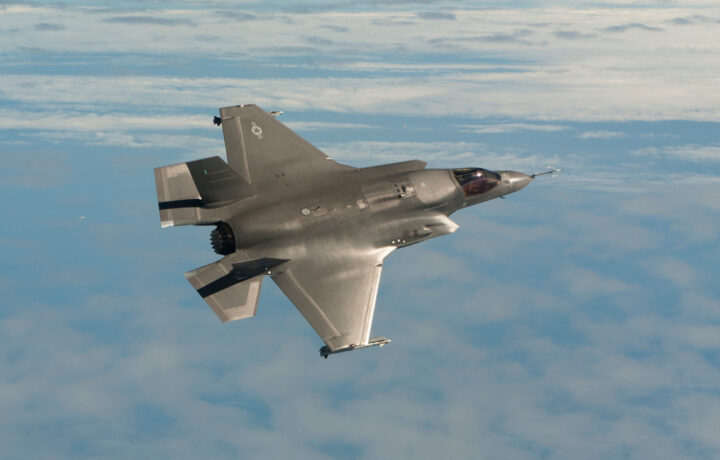The United States Marine Corps announced this past weekend that Marine Fighter Attack Squadron (VMFA) 211, from Marine Corps Air Station Yuma, Arizona, has been deployed to MCAS Iwakuni, Japan, under the service’s Unit Deployment Program. VMFA-211, the “Wake Island Avengers,” currently operates the Lockheed Martin F-35B Lightning II, the short takeoff and vertical landing (STOVL) variant of the Joint Strike Fighter.
The stealth fighter squadron will join Marine Aircraft Group (MAG) 12, 1st Marine Aircraft Wing in support of flight operations across the Indo-Pacific region as part of the service’s ongoing Unit Deployment Program (UDP), which has sought to reinforce its presence in the Indo-Pacific.
The UDP allows units that are normally stationed in the continental United States to be rotated to forward positions in the region.
“The Wake Island Avengers will augment 1st Marine Aircraft Wing in providing critical aviation support from naval and expeditionary environments. This allows the Marine Corps to ensure operational readiness as obligated in support of the U.S.-Japan Treaty of Mutual Cooperation and Security,” MCAS Iwakuni said in a statement.
VMPA-211 previously operated the McDonnell Douglas AV-8B Harrier II, and it received its first pair of F-35Bs in May 2016. It later became the second fleet squadron in the USMC to operate the Lightning II as its primary aircraft.
The Right Plane For the Job?
The F-35 Lightning II is produced in three main variants for the U.S. military, including the F-35A, a conventional takeoff and landing (CTOL) version; the F-35B, the STOVL model; and the F-35C, a carrier-based version that features larger wings and fuel tank. The United States Air Force operates the F-35A, while the U.S. Navy operates the F-35C, with the United States Marine Corps operating both the F-35B and C models.
The F-35B model is outfitted with a lift fan that allows for the STOVL. That allows the aircraft to be operated from the U.S. Navy’s amphibious assault ships, where it can support USMC expeditionary operations, as well as from austere forward bases.
However, as part of its current Aviation Plan (AVPLAN), the USMC has sought to double the number of F-35s from 67 to 140 to support U.S. Navy carrier deployments and Marine Corps TACAIR global priorities. The AVPLAN would also reduce the total number of future F-35Bs from 353 to 280. The service has committed to maintaining its goal of 420 F-35s in service.
The reason for the shift has been the mission-capable rate of the F-35B seeing a decline, while the carrier-launched F-35C has seen measurable improvement in recent years. However, its eventual 280 F-35Bs will still allow it to support its role on the U.S. Navy’s Wasp-class landing helicopter dock (LHD) amphibious assault ships and the America-class landing helicopter assault (LHA) amphibious assault ship, while also supporting foreign partners.
F-35Bs from VMFA-211 previously operated from the Royal Navy’s HMS Queen Elizabeth aircraft carrier during the then-flagship’s historic 2021 deployment to the Indo-Pacific.
A Storied Squadron
The squadron now known as the Wake Island Avengers was first commissioned in January 1937 as Marine Fighting Squadron 4 (VF-4M) at Naval Air Station San Diego, later re-designated Marine Fighting Squadron 2 (VMF-2) and then VMF-211.
Just days before the Japanese attack on Pearl Harbor on December 7, 1941, a dozen VMF-211’s Grumman F4F Wildcats were deployed to Wake Island in the Pacific Ocean. The Imperial Japanese Navy launched its attack on Wake on December 8, destroying seven of the fighters on the ground. However, for two weeks, the remaining five planes repelled numerous attacks, while sinking at least four enemy warships – the first major Japanese vessels sunk in the Pacific War.
VMF-211’s Captain Henry T. Elrod, flying a Wildcat, became the first U.S. Marine airman to be awarded the Medal of Honor for his actions during the Wake Island campaign. He was killed in the subsequent fighting.
The unit continued to see combat operations throughout the Second World War, later flying the Grumman F4F-4 Wildcats and then the Vought F4U Corsair. VMF-211 participated in several notable actions including the Battle of the Bismarck Sea and the Battle of Leyte Gulf.
During the Cold War, in June 1952, the squadron was redesignated Marine Attack Squadron 211 (VMA-211). It transitioned to the AV-8B Night Attack variant of the Harrier in June 1990, while the Wake Island Avengers were awarded the Marine Corps Aviation Association “Attack Squadron of the Year” three times, including 1995, 1996, and 1998.




